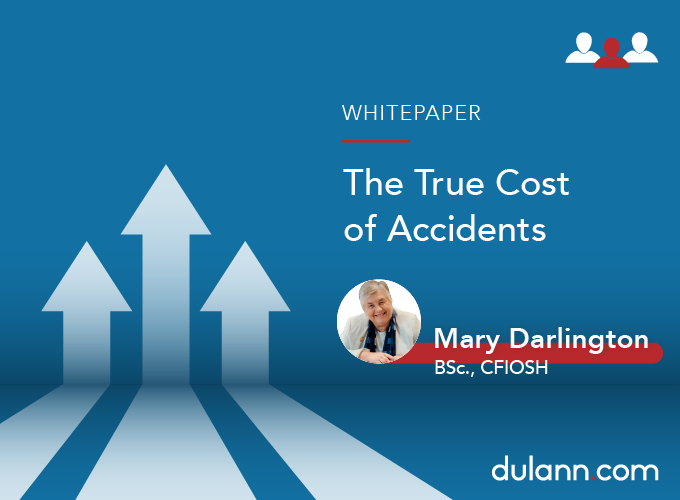Objective
In this White Paper, I want to open up a discussion and debate on how much accidents at work are costing individual victims, businesses, the community and the Country as a whole.
Summary of Findings
Conclusions
We need much more up-to-date research on the true costs of accidents within Ireland. Many employers do not yet understand the financial benefits of preventative, proactive, health and safety programmes in their workplaces as they do not cost accidents comprehensively at all. Therefore, businesses have no real data on what accidents, ill-health and absences are costing them.
If they did, they would understand the money they are losing, and the impact that is having on their profitability and viability, and hopefully, that would motivate them to put sufficient resources into Health and Safety Programmes.
In my own professional career when I train or speak to CEOs and Senior Managers about health and safety, I always talk about Economics and what their current poor health and safety performance is costing them. For many of them, it is a huge wake-up call as they only ever considered health and safety as a cost on the balance sheet rather than an investment that pays dividends over time.
Recommendations
Health and Safety Professionals, both inside Organisations and those operating as Consultants, need to be able to talk Economics to CEOs and others, as sometimes that is the only way to get the message through at the Management level. Briefing them about their legal obligations under both Common Law and the Safety, Health & Welfare at Work Act 2005 (and associated Regulations) will not endear them to the key decision-makers.
We need tools to assist with costing including the legal cost and insurance elements of accidents.
The impact on the employees injured, some of whom do not return to the work at all or return to do a different job that they are capable of doing, needs to be better quantified. We can count compensation payouts, we can tally up lost wages and salaries but it is far more difficult to put monetary figures on the opportunities lost, the time with family interrupted, the hobbies dropped and the travel that is no longer possible etc.
Health and safety need to be framed not just as a legal and moral topic but as an economic one.
Introduction
Ireland has been discussing the costs of accidents since the Barrington Commission sat in 1983 (this Commission led to the establishment of the Health and Safety Authority in legislation in 1989). In their report, Chapter 19 they had this to say about the financial cost of accidents and illness:
19.1 We regarded it as part of our task to attempt to establish some idea of the orders of magnitude of the financial costs of accidents and ill health at work. There were three reasons for this.
First, there is growing recognition that accidents and occupational illness represent considerable losses to employers, to the Exchequer and to society. If we were to recommend a system which imposed considerable costs on employers or on the public purse, it seemed logical to attempt to present also the potential benefits in terms of reduced accidents and consequential savings.
Secondly, we formed the impression very quickly that many employers have no idea of the total cost of accidents to them. Generally, they underestimate costs. Those who have attempted some study of the situation have found that there were significantly greater costs than the annual insurance premium. Simply highlighting this fact is an important exercise.
Thirdly, we expect that here, as elsewhere, decision-makers will look more and more closely at the economic consequences of various proposals before they pass into law. Occupational safety and health are quite separate from ordinary market activities and therefore not all proposals will be amenable to cost-effectiveness studies. Nevertheless, the absence of any major study or discussion on the methodology of costing could be a major stumbling block later to a rational discussion of alternative proposals or strategies. (1)
It needs to be a live issue in all businesses but it is not.
In my own Experience
Even in my own work, when I discuss accident costs with Senior Managers and others, I use a case study which is detailed below in Appendix A. It lays out a simple accident, not entailing 3 days’ absence or more, and asks Managers to work out what it has cost. Many are truly shocked by the costs and had, prior to the training, written off incidents like this as minor and generally not worth bothering about. In my view every accident, no matter how slight, should be costed. Even minor accidents can cost up to €500, and if you have 10 of those a year then €5,000 has been lost and no one is actually tracking it.
Obviously, once the injured person begins to lose time, begins to receive sick pay, and/or takes a claim against the employer, then the costs begin to rise. Even if the employer subsequently wins the compensation claim there are still major costs in going to court, engaging solicitors, and barristers, preparing Managers to testify, bringing in expert witnesses etc.
Important Definition – What is an accident?
An accident is an unplanned event resulting in death or resulting in an injury such as a severe sprain or strain (for example, manual handling injuries), a laceration, a broken bone, concussion or unconsciousness. (2)
In this Whitepaper I am only dealing with non-fatal accidents and am not going into the issues around accident causation, prevention or investigation, they are for another paper.
Some Statistics
Statistics from ILO
I am quoting from slide 5 (“Costs” of occupational accidents and diseases) from an ILO webinar entitled: Learning from work-related accidents delivered by António J. Robalo Santos on 11th February 2021 which states that the costs are as follows:
- UK: EUR€18.1 billion (HSE, 2015)
- USA: US$250 billion - 1.8% of GDP (Miller, 1997)
- EU: EUR€26 billion (Richthofen, 2002)
- World: US$1,200 billion- 4% of global GNP (Hämäläinen, 2009; Takala, 2014, 2005) (3)
Statistics from EU
Fatal accidents at work in the EU decreased by about 70% between 1994 and 2018. While factors such as de-industrialisation and better medical care have undoubtedly contributed to this decrease, the EU OSH system has also played a substantial role. Despite this progress, there were still over 3 300 fatal accidents and 3.1 million non-fatal accidents in the EU-27 in 2018, and over 200 000 workers die each year from work-related illnesses.
Work-related accidents and illnesses cost the EU economy over 3.3% of GDP annually ( EUR 460 billion in 2019). While the cost to well-being behind these numbers is unquantifiable, good practice in OSH helps make businesses more productive, competitive and sustainable. Estimates show that for every euro invested in OSH, the return for the employer is around twice as much. (4)
Statistics from Ireland
“In 2020, 7,417 non-fatal incidents were reported to the Health and Safety Authority, a 20.7% reduction from the 9,358 reported in 2019. It is likely that this reduction in reported incidents is largely due to public health measures introduced as a result of the COVID-19 pandemic. Reductions were recorded in every economic sector except Agriculture, Forestry and Fishing. (5)
So over 7 thousand people were injured at work or by work activity, sufficiently seriously for the employer to notify HSA when they had been absent for more than 3 days. The table below confirms that 94.1% were employees.
Number of reported non-fatal incidents by employment status, 2020 (HSA)
Figure 2.2 from Annual Review of Workplace Injuries, Illnesses and Fatalities
2019–2020
The top five reported non-fatal injuries by trigger 2020 were:
- Manual Handling
- Slipping and falling
- Loss of control of the object, machine, vehicle, etc.
- Aggression, shock, violence
- Body movement leads to cuts, bruises (external injuries)
Figure 2.3 from Annual Review of Workplace Injuries, Illnesses and Fatalities
2019–2020
So what do we know about the Cost of Accidents?
In 2004 there was a study done by the Health and Safety Authority on the costs of accidents in high-risk sectors such as Construction, Agriculture, Hunting, Forestry, Mines and Quarries. These sectors were considered to be at significantly higher risk for workplace accidents.
The average costs to employers were found to be as follows:
Construction in 2002 was €17,138
Mines and Quarries had an average cost of €8,725 for 2002 and 2003,
Agriculture and Forestry had an average of €1,969 for 2002 and 2003.
The average cost allows for the implication of a total cost. If this figure is applied to all of the reported accidents, the three sectors combined spent a total of €21,384,384 in Ireland in 2002 alone.
One of their main conclusions was that “there are many costs which are not so obvious that occur when an accident happens such as interruption in productivity, effects on worker morale, and office procedures involved when dealing with an accident.” (6)
2007 Study of Irish Accidents re Costs
The last major study on the costs of accidents in Ireland was carried out in 2007. Its title was “The costs and effects of workplace accidents” - Twenty case studies from Ireland - A report for the Health and Safety Authority by: Mr Victor Hrymak & Dr Jose Damian Pérezgonzález,
The specific research objective was to identify the financial, physical and psychological effects that workplace accidents can have on employers and employees.
The following costs were considered:
Employer costs included:
∙ Lost business opportunities
∙ Productivity losses
∙ Salary of the absent injured employee
∙ Expenses reimbursed to the injured employee
∙ Repair, rental or replacement costs
∙ Insurance premium changes and legal costs
∙ Any “PR”, “IR”, reputational or corporate & social responsibility costs
∙ Additional training or supervisory costs
Employee costs included;
∙ Loss of salary
∙ Loss of overtime payments
∙ Medical, travel or other expenses
∙ Compensation received
∙ Lost savings
∙ Retraining costs
∙ Pay differences from any new employer
In terms of financial costs to employers, the amounts varied greatly from €0 to over €3.8 million. The average cost of the twelve middle-range accidents was approximately €52,000. The costs found were in almost all cases underestimated as productivity losses (with one exception) were not recorded by employers. Nearly half (8) of the more serious accidents in the case studies resulted in personal injury claims. Of the four settled claims, three compensation awards came to approximately €30,000 and the remaining award was for €152,000.
Employer costs from the accidents included salary costs for replacement staff or overtime payments, production and productivity losses, retraining costs, personal injury claim compensation, repair bills, medical & travel expenses and increased supervision. Salary costs were the largest cost category, being nearly half (45%) of total losses. Resentment towards the employer from the injured employee was also reported.
The amount of money lost by employees varied greatly. Seven employees did not lose any money. Over half (12) lost money and the amounts varied from less than €1,000 to €112,000; the average loss of these twelve employees was approximately €21,000. These figures take account of any compensation received. Where employees lost money, the largest proportion, approximately 85%, was due to lost salary and overtime payments. One quarter (5) of the injured employees are incurring ongoing financial losses due to a change in employment status as a result of the accident. If their circumstances do not change, these employees are set to lose between €38,000 and €268,000 over the remainder of their careers. (7)
EU Study on Costs
In 2014 the European Agency for Safety and Health at Work- did a study to estimate the cost of accidents and ill-health at work. In this study costs were categorised into five main types:
- Productivity costs: costs related to decreases in output or production.
- Healthcare costs: medical costs, including both direct (e.g. pharmaceuticals) and indirect (e.g. caregiver time).
- Quality of life losses: monetary valuation of the decrease in quality of life, such as physical pain and suffering.
- Administration costs: costs of administration, for example, applying for social security payments or reporting on a workplace accident.
- Insurance costs: costs regarding insurance, such as compensation payments and insurance premiums.
These five main cost types are further assessed by the perspective(s) taken, that is, in terms of costs to four stakeholders, namely:
- Workers and family: the affected individual and close family or friends who are affected by the injury or illness.
- Employers: the company or organisation for which the affected individual works.
- Government: the relevant public authority regarding, for example, social security payments.
- Society: all stakeholders — the effect on society is the overall impact of an injury or illness, excluding transfers between stakeholders (which cancel out).
Page 37 - of the report discusses ‘Presenteeism’, or reduced productivity while at work, and clarifies that it is not quantified by any of the studies above, as it is very difficult to measure productivity drops at work. (8)
How do we compare to the UK?
Royal Society for the Prevention of Accidents in the UK (RoSPA) carried out some research in the UK in 2012 and concluded the following:
“Britain has a relatively good health and safety record yet 1.8 million people suffered from a work-related illness and over 640,000 workplace injuries were reported in 2012/13, with 27 million working days lost in 2011/12 due to work-related ill health or injury. The cost to British employers of health and safety failure was estimated to be £2.8 billion in 2010/11”.
They also commented on Insured and uninsured costs – saying “Most organisations do not know what accidents and ill-health really cost them in time and money. Few bother to examine costs if and when they investigate accidents and incidents.
It is often assumed that most accident and incident costs are recoverable through insurance. This is a dangerous misconception. The HSE estimates that uninsured losses are ten times the cost of insurance premiums paid with uninsured losses from accidents in smaller firms adding up to £315 per employee, per year.” (9)
More UK statistics
The latest estimates show that annually between 2017/18 and 2019/20 an average of 610,000 workers were injured in workplace accidents and a further 559,000 workers suffered a new case of ill health which they believe to be caused or made worse by their work.
The total costs of workplace self-reported injuries and ill health in 2018/19 was £16.2 billion. Ill health causes the biggest proportion of total costs at around 66% (£10.6 billion), with injury resulting in around 34% of total costs (£5.6 billion).
Individual costs are £9.6 bn.
Costs to the employer are £3.2 bn. Costs to the Government are £3.5 bn.
The majority of costs fall on individuals, driven by human costs, while employers and government/taxpayers bear a similar proportion of the remaining costs of workplace injury and ill health. (10)
Why are Costs Important?
All businesses try to manage costs and drive them down, and health and safety are no different. Accident costs eat into operational budgets and can impact profits. They can also cause insurance premiums to rise if an organisation is having lots of accidents and paying out compensation to injured employees and others.
Many years ago I was aware of a company that, having done tremendous work in the health and safety area and having reduced risks throughout the company, began negotiations with their Insurance Company regarding their Employer’s Liability premium. After some tough-talking, they managed to get the premium down and then they kept it down which was unheard of at the time. Most Employer’s Liability premiums are calculated as a % of overall payroll so as your number of employees increases, your premiums rise with it.
This company was actively recruiting so employee numbers were rising but now the Employer’s Liability Premium was going down when payroll was rising. This enabled the company to calculate what they would have been paying a premium, had nothing changed, and what they were now paying. The savings they realised paid in full for the EHS Manager and the Occupational Health Manager at the time and there was money left over which was re-invested in more health and safety programmes.
So saving money by having effective health and safety programmes is doable and again it should be measured.
References
1: Report of the Commission of Inquiry on Safety Health and Welfare at Work 1983
3: ILO webinar entitled: Learning from work-related accidents delivered by António J. Robalo Santos on 11th February 2021 - slide 5 (“Costs” of occupational accidents and diseases)
5: Annual Review of Workplace Injuries, Illnesses and Fatalities 2019–2020
9: RoSPA - Costing accidents - The business case 2012
10: Costs to Great Britain of workplace injuries and new cases of work-related Ill Health – 2018/19
Appendix A
Costs Exercise
Back injury
Tom, a Manufacturing Operator, hurts his back, mid-morning, while lifting something. He collapses in pain and is seen initially by a first aider who puts an ice pack on his back and then he is sent home in a taxi with the First Aider, which the company pays for.
He loses the rest of that day and then goes to his Doctor the following day and is put on light duties for a week. He returns to work after the Doctors visit. His normal work is now being done by another Operator who does this for 4 days. He is put sitting down, reviewing SOPs.
He does not lose a single full day from work and he does not make a claim against the Company. How much has Tom’s accident cost you?
Here are some headings to guide you:
Written by: Mary Darlington – BSc., CFIOSH
Safety Leadership Expert
Chartered Safety and Health Practitioner
March 2022







